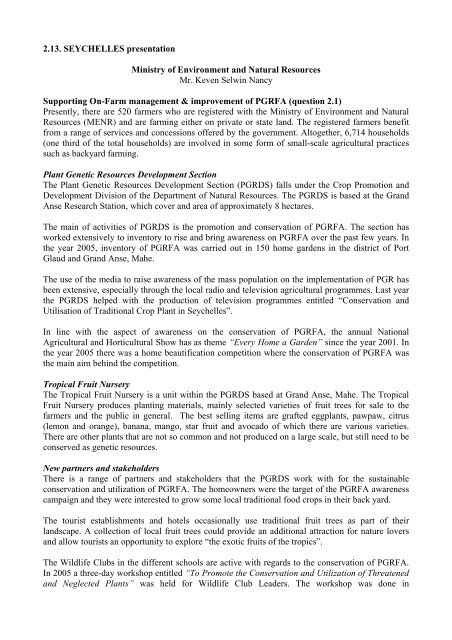Improving the identification, handling and storage of âdifficultâ seeds ...
Improving the identification, handling and storage of âdifficultâ seeds ...
Improving the identification, handling and storage of âdifficultâ seeds ...
Create successful ePaper yourself
Turn your PDF publications into a flip-book with our unique Google optimized e-Paper software.
2.13. SEYCHELLES presentation<br />
Ministry <strong>of</strong> Environment <strong>and</strong> Natural Resources<br />
Mr. Keven Selwin Nancy<br />
Supporting On-Farm management & improvement <strong>of</strong> PGRFA (question 2.1)<br />
Presently, <strong>the</strong>re are 520 farmers who are registered with <strong>the</strong> Ministry <strong>of</strong> Environment <strong>and</strong> Natural<br />
Resources (MENR) <strong>and</strong> are farming ei<strong>the</strong>r on private or state l<strong>and</strong>. The registered farmers benefit<br />
from a range <strong>of</strong> services <strong>and</strong> concessions <strong>of</strong>fered by <strong>the</strong> government. Altoge<strong>the</strong>r, 6,714 households<br />
(one third <strong>of</strong> <strong>the</strong> total households) are involved in some form <strong>of</strong> small-scale agricultural practices<br />
such as backyard farming.<br />
Plant Genetic Resources Development Section<br />
The Plant Genetic Resources Development Section (PGRDS) falls under <strong>the</strong> Crop Promotion <strong>and</strong><br />
Development Division <strong>of</strong> <strong>the</strong> Department <strong>of</strong> Natural Resources. The PGRDS is based at <strong>the</strong> Gr<strong>and</strong><br />
Anse Research Station, which cover <strong>and</strong> area <strong>of</strong> approximately 8 hectares.<br />
The main <strong>of</strong> activities <strong>of</strong> PGRDS is <strong>the</strong> promotion <strong>and</strong> conservation <strong>of</strong> PGRFA. The section has<br />
worked extensively to inventory to rise <strong>and</strong> bring awareness on PGRFA over <strong>the</strong> past few years. In<br />
<strong>the</strong> year 2005, inventory <strong>of</strong> PGRFA was carried out in 150 home gardens in <strong>the</strong> district <strong>of</strong> Port<br />
Glaud <strong>and</strong> Gr<strong>and</strong> Anse, Mahe.<br />
The use <strong>of</strong> <strong>the</strong> media to raise awareness <strong>of</strong> <strong>the</strong> mass population on <strong>the</strong> implementation <strong>of</strong> PGR has<br />
been extensive, especially through <strong>the</strong> local radio <strong>and</strong> television agricultural programmes. Last year<br />
<strong>the</strong> PGRDS helped with <strong>the</strong> production <strong>of</strong> television programmes entitled “Conservation <strong>and</strong><br />
Utilisation <strong>of</strong> Traditional Crop Plant in Seychelles”.<br />
In line with <strong>the</strong> aspect <strong>of</strong> awareness on <strong>the</strong> conservation <strong>of</strong> PGRFA, <strong>the</strong> annual National<br />
Agricultural <strong>and</strong> Horticultural Show has as <strong>the</strong>me “Every Home a Garden” since <strong>the</strong> year 2001. In<br />
<strong>the</strong> year 2005 <strong>the</strong>re was a home beautification competition where <strong>the</strong> conservation <strong>of</strong> PGRFA was<br />
<strong>the</strong> main aim behind <strong>the</strong> competition.<br />
Tropical Fruit Nursery<br />
The Tropical Fruit Nursery is a unit within <strong>the</strong> PGRDS based at Gr<strong>and</strong> Anse, Mahe. The Tropical<br />
Fruit Nursery produces planting materials, mainly selected varieties <strong>of</strong> fruit trees for sale to <strong>the</strong><br />
farmers <strong>and</strong> <strong>the</strong> public in general. The best selling items are grafted eggplants, pawpaw, citrus<br />
(lemon <strong>and</strong> orange), banana, mango, star fruit <strong>and</strong> avocado <strong>of</strong> which <strong>the</strong>re are various varieties.<br />
There are o<strong>the</strong>r plants that are not so common <strong>and</strong> not produced on a large scale, but still need to be<br />
conserved as genetic resources.<br />
New partners <strong>and</strong> stakeholders<br />
There is a range <strong>of</strong> partners <strong>and</strong> stakeholders that <strong>the</strong> PGRDS work with for <strong>the</strong> sustainable<br />
conservation <strong>and</strong> utilization <strong>of</strong> PGRFA. The homeowners were <strong>the</strong> target <strong>of</strong> <strong>the</strong> PGRFA awareness<br />
campaign <strong>and</strong> <strong>the</strong>y were interested to grow some local traditional food crops in <strong>the</strong>ir back yard.<br />
The tourist establishments <strong>and</strong> hotels occasionally use traditional fruit trees as part <strong>of</strong> <strong>the</strong>ir<br />
l<strong>and</strong>scape. A collection <strong>of</strong> local fruit trees could provide an additional attraction for nature lovers<br />
<strong>and</strong> allow tourists an opportunity to explore “<strong>the</strong> exotic fruits <strong>of</strong> <strong>the</strong> tropics”.<br />
The Wildlife Clubs in <strong>the</strong> different schools are active with regards to <strong>the</strong> conservation <strong>of</strong> PGRFA.<br />
In 2005 a three-day workshop entitled “To Promote <strong>the</strong> Conservation <strong>and</strong> Utilization <strong>of</strong> Threatened<br />
<strong>and</strong> Neglected Plants” was held for Wildlife Club Leaders. The workshop was done in

















